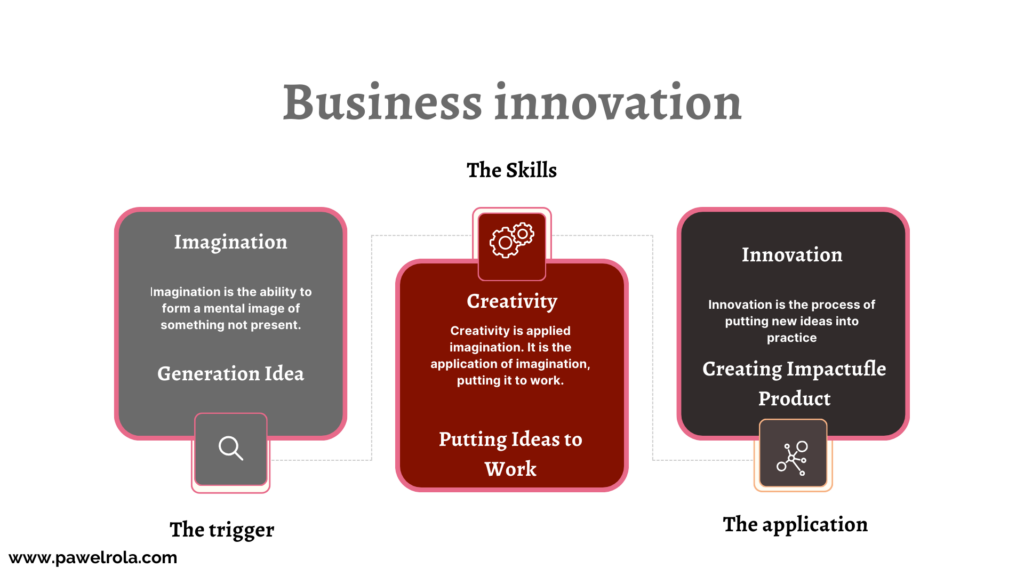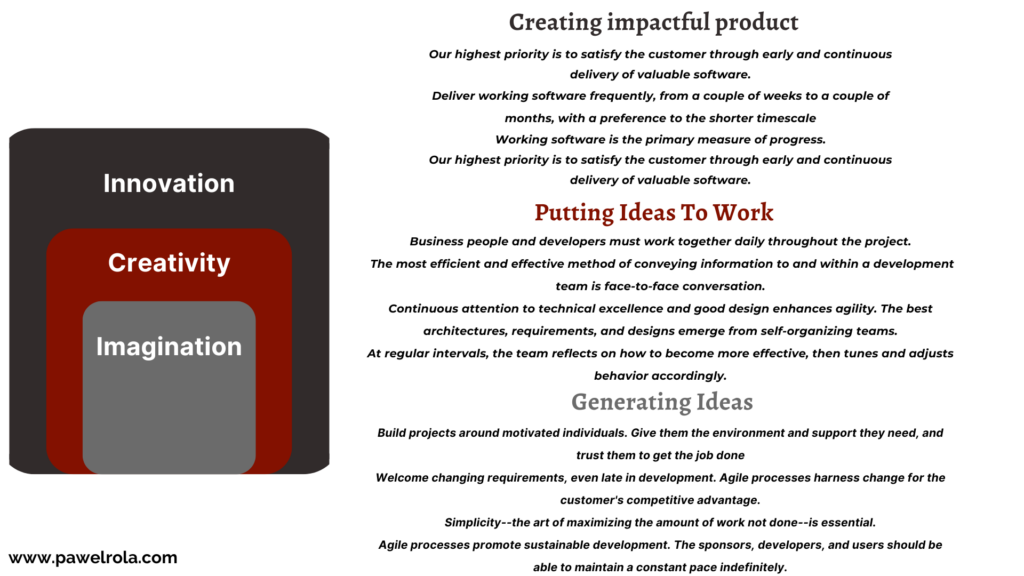How to Start Innovation In Business; How Leaders Can Encourage Business Innovation
This article has been written for you if you’re into business innovation or if you’re dealing with challenges such as:
- Has your boss ever told you that you need to be more innovative? productive, just as she or he usually asks you to be more effective?
- You want to ignite innovation within your company but are unsure where to begin.
- You understand the importance of innovation for business and want to put it into practice.
If any of this triggers a reaction, in this text, I will share a few practical tips for boosting innovation in your business or the teams you manage. This article touches on the basics, but remember, every journey starts with taking that first step!
Need for innovation
In a world of evolving technology, changing legislation, and shifting customer expectations, companies face unprecedented challenges and exciting prospects for growth through innovation.
Companies that are more efficient in innovation generally have higher current market valuations and better future operating performance, market valuation, and stock returns (David Hirshleifer, Volume 107, Issue 3,).
How to be innovative?
Or it is easier to say than be?
Sir Ken Robinson defines innovation as applied creativity. (Robinson, 2024) Business innovation introduces new ideas, workflows, methodologies, services, and products or improves any of those already existing in the business context.
But before innovation can flourish, imagination and creativity are needed. The relationship between imagination and creativity is presented below based on a model. It describes ways in which people learn in a natural environment. We can utilise it to enhance and improve business performance and results, which can be treated as a learning process and implementation of learning results in a business context. Figure 1 illustrates the process for implementing business innovation.

Figure 1 Business innovation steps. Author’s elaboration based on (Renzulli, Ronald, Laurel, Brandon i Karwowski, 2021)
Environment for Business Innovation
Business innovation requires ingredients (such as time, energy, money, and talented, creative people) and a supportive organizational culture. We will examine the latter.
It is essential to highlight that fostering innovation relies on developing a unique organisational culture, a culture where people are encouraged to explore new ideas, share them, and are confident that they won’t be punished for mistakes or failures, which are natural parts of the innovative process.
What can my co-workers and teams do?
Be mindful of common leadership pitfalls. Innovation can feel daunting when the pressure to create something new looms large. As leaders, our role is to create an environment where exploration feels natural, not forced.
Depending solely on Change Makers, whether from within your team or externally, will not be enough from a leadership standpoint. Forward-thinking, ambitious leaders aspiring to enhance, streamline, and advance businesses must take a more proactive approach.
A Leadership Approach
One of the most meaningful steps a leader can take is to create an innovative culture. Leadership plays a pivotal role in shaping and influencing organisational culture.
You are the visible supporter, example, and motivator for a strong, thriving, innovative culture. Whether you like it or not, people throughout the organisation will always look to the leaders for guidance on what counts in the culture. (Perkins, 2021).
Learn from other experiences.
Great leaders meticulously and practically learn and draw inspiration from the experiences of other leaders. The technology sector is one of the most innovative and rapidly advancing industries.
The Agile Manifesto (K. Beck, 2001) has revolutionised the information technology industry over the past two decades. It has significantly improved development success rates and overall outcomes related to projects or products delivered in that field. The Agile Mindset is a well-recognized factor that facilitates the transition into the digital age (Digital.ai, 2023).
Numerous technological advancements have shaped the current era and will continue to have a significant impact. The Agile Manifesto’s four values and 12 principles have significantly impacted the culture of well-known companies such as Amazon, Spotify, Google, Lego, BP, Microsoft, and many others.
Changes begin at home
Leaders must embrace change and vulnerability, as resistance to change is common. The first step should be on a personal level. One of the possible steps is to use an approach that empowers the technology sector and grasp what it means from your perspective. Do your homework and reconsider how the Agile Manifesto can impact your actions, behaviours, and communication with co-workers.
Leaders might consciously overcome challenges and difficulties in the learning process by evolving a growth mindset. The growth-mindset (Dweck, 2007)
helps people feel positive in the short and long term by helping them thrive on challenges and setbacks on their way to learning.
Those with a growth mindset proficiently reject limitations due to real or perceived deficiencies. They are convinced that success is assured through hard work, perseverance, and practice. The growth mindset is an intellectual concept that individuals can work on.
Lead by example. Be a realistic and practical leader by initiating any change within yourself. You will be surprised how often even seemingly small changes in leadership might impact your team or organisation. This is a crucial step towards initiating more substantial transformations. As a leader, you possess significant leverage, which means that even small changes can potentially have a considerable impact.
If you work on self-improvement, success will follow.
Individuals’ personal growth and development influence their leadership styles. Leaders often progressively lean towards servant leadership for its significant benefits. This style enables organisational changes by directly influencing colleagues and subordinates.
Leaders plant the seeds for the future evolution of the organisational culture and values. This will gradually unleash innovative personal behaviours and inspire knowledge-sharing among employees, leading to a more dynamic working environment.
As leaders, embracing the mindset of a learner not only helps us innovate but also sets a powerful example for our teams, showing that growth is a continuous process.
Ideas are only valuable with execution.
Agility is closely linked to offering innovative solutions to customer problems. It is a mindset that fosters curiosity in understanding customer needs and excellence in execution, ultimately leading to business implementation and validation. It sets the direction toward addressing significant and realistic customer challenges.
The values of Agile serve as our guiding priorities, assisting us in decision-making. On the other hand, the Agile principles act as our rulebook, governing our behaviour. Considering this perspective, let’s examine whether these governing behaviours (Agile principles) align with and support the business innovation process.
Figure 2 illustrates which agile principles can support and govern behaviours in the specific step of business innovation. Three previously mentioned innovation steps ( Imagination, Creativity, and Innovation) were matched with 12 Agile principles.

Figure 2 Agile principles support the business innovation steps. Source: Own elaboration
Business innovation doesn’t have a one-size-fits-all formula, but successful organisations set themselves apart with a unique culture that supports the innovation process. With its values and principles, the Agile Manifesto can help create such a culture.
Design breakthrough solutions.
Embracing a potent fusion of imagination, creativity, and innovation, upheld by a mindful leader, can create an environment where the status quo is no longer tolerated.
When people actively and creatively work together in a culture that values creativity and collaboration, they generate fresh ideas and solutions while ensuring they meet customers’ needs through excellent service or product delivery.
When you support and invest in creating a positive innovation environment and serving your people as a leader, there’s a good chance that someone within your team will identify and draw attention to the underlying issue.
Clearly defining the real problems and the solutions created to address them is crucial for the success of any organisation.
Addressing customers’ genuine problems innovatively and building a business based on solving these problems have proved to be key factors in companies’ long-term success.
It helps organisations like Netflix, Uber, and Spotify revolutionise their respective fields and have a long-lasting impact on society. Perhaps your organization will begin the journey toward business innovation. As a leader, your next step—no matter how small—can spark transformation. What will you do today to drive innovation forward in your organization?
Share this content:
Bibliography
David Hirshleifer, P.-H. H. (Volume 107, Issue 3,). Innovative efficiency and stock returns. Journal of Financial Economics,, 632-654,.
Perkins, K. M. (2021, Dec 10). Leaders Own Responsibility For Culture: Make It A Top Priority Next Year. From Forbes.com: https://www.forbes.com/sites/deloitte/2024/08/20/accelerating-progress-a-phased-approach-to-greater-sustainability-in-metals-and-mining/?
K. Beck, M. B. (2001). Manifesto for Agile Software Development. From Manifesto for Agile Software Development: http://www.agilemanifesto.org/
Digital.ai. (2023). 17th State of Agile Report. Digital.ai.
Robinson, K. (2024, September 1). Continuing Sir Ken Robinson’s Legacy of Creativity & Innovation. From https://www.sirkenrobinson.com
Renzulli, J. S., Ronald, Laurel, A. B., Brandon, E., & Karwowski, M. (2021). Development of an instrument to measure opportunities for Imagination, Creativity, and Innovation (ICI) in schools. Gifted Education International,, 1–20.
Dweck, C. S. (2007). Mindset: The New Psychology of S uccess. New York: Balantine Books.
